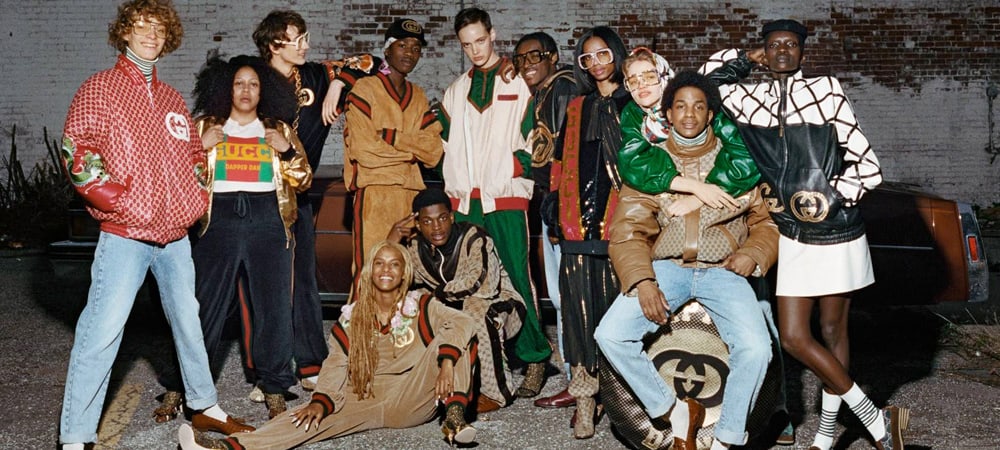

In 2002, stylist Rachel Johnson walked into a Burberry store in New York to request some clothes for a photoshoot. Her client was Ja Rule, then promoting the follow-up to his Grammy-nominated, triple-platinum album Pain is Love. It was the kind of exposure that brands generally love, but Burberry refused to help.
“They didn’t want him to wear their stuff,” Johnson later told Newsweek. “People have this stigma with the urban community.” She bought it anyway and after she draped her client in the brand’s house check, his fans did too. A few months later, Burberry sent Ja Rule a letter of thanks.
A decade and more on, the brand has a different stance on hip-hop style. It’s dressed Skepta and Nicki Minaj and recently collaborated with Chinese rapper Kris Wu. Like the rest of the fashion industry, Burberry coincidentally overcame its distaste for rap just as rap became the loudest sound on earth; in December, Nielsen research found more people listened to rap than rock for the first time. Now it’s brands like Burberry that come knocking, and rappers who rebuff them.
“With hip-hop being the de facto sound of youth and rebellion, a lot of the prominent artists – be it Beyoncé or Kanye West or ASAP Rocky – are now like, ‘Why am I giving people free press?’” says Jian DeLeon, editorial director at Highsnobiety.
Luxury logos have always been signals of success hip-hop, but rap’s explosion has shifted expectations. “They understand that they are now brands and they understand the power that their brands have. They’re not just using it to promote these symbols that they’ve made it. They know that they’ve made it.”
Ever since DJ Kool Herc’s first block parties, hip-hop has been a voice for the marginalised. Its look mattered as much as the sound, partly as an expression of self-identity, partly as shorthand for success. For those pioneering black artists who grew up amid crime and violence, whose music helped them transcend their place of birth and their lack of opportunities, European luxury brands were the original flex; a middle finger to a society that had written them off and a diamond-dripping, mink-trimmed embodiment of the American Dream for the people who bought their records.
True Street Wear
Rap is arguably music’s most entrepreneurial genre, obsessed with graft and hustle, status and the path up from the streets. No other sound has focused so much on starting from the bottom, perhaps because no other music has been so dominated by artists who started life at the bottom. The uniform of rock was stuff that would frighten fans’ mothers; for rap, it was clothes that backed up your bars.
Rap’s first commercial flush put its stars in financial reach of luxury, but they were still locked out by geography and race. Their focus on the grittier sides of street culture made brands wary. Biggie might big up Louis Vuitton, but its customers were white, old and didn’t want their couturier draped across an ex-drug dealer.
They were even less comfortable about selling to actual drug dealers, the only other people in Harlem in with the cash to afford them. They refused to wholesale there and made their Fifth Avenue stores as unwelcoming to young black men as possible. That inaccessibility made luxury even more covetable. So Harlem’s tailors figured out a workaround.
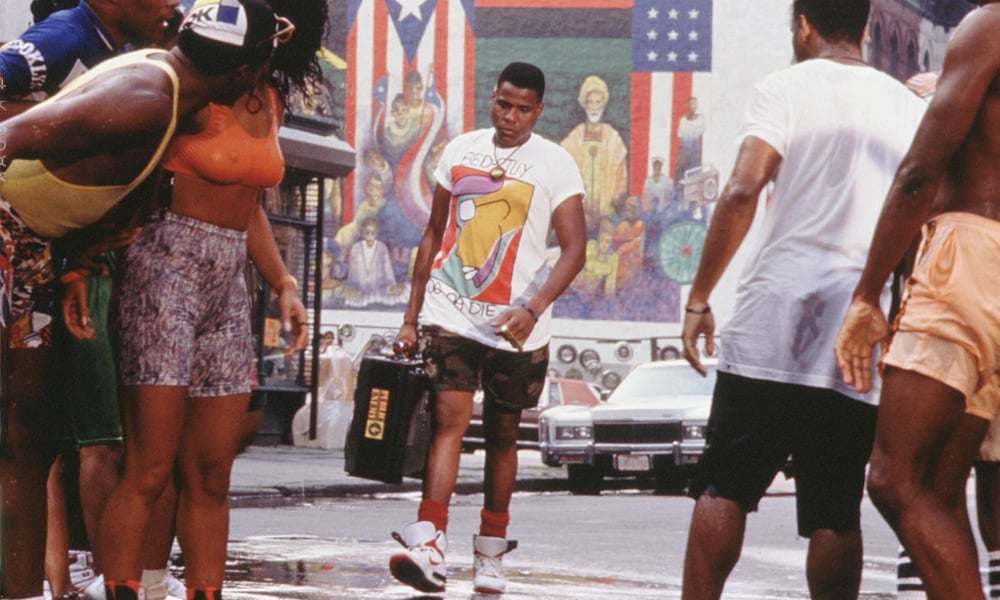 Do The Right Thing – Bill Nunn, 1989
Do The Right Thing – Bill Nunn, 1989The go-to was Dapper Dan, born Daniel Day, a haberdasher who would import bootlegged fabrics or screen-print logos onto luxury leather, then turn them into one-of-a-kind, street-inflected pieces like oversized bomber jackets and fur-trimmed coats. His clothes weren’t the copies of runway fashion you find on eBay; they were unique, hand-crafted and often more expensive than the originals. Particularly if you wanted something you’d never find in Fendi, like a parka with bulletproof panels, or hidden stash pockets.
“Dapper Dan has a term for what he did in the 1980s: ‘blackinize fashion’,” says Rachel Lifter, assistant professor of fashion studies at Parsons School of Design. His clothes embodied street culture and the needs and wants of people who were young and rich, but locked out of the things enjoyed by young, rich, white people. “He drew on a long legacy of black style as both a form of self-realisation and a statement of political-aesthetic resistance.”
Day defined hip-hop style for a decade – oversized, influenced by sportswear as much as luxury tailoring and designed to make sense in the street. It was clothing infused with swagger and for a rapper on the up-and-up, copping a Dapper Dan was a sign you’d made it.
“Rappers have always liked fashion and fashion for the longest time didn’t want to speak to that audience because it felt like it might have hurt the integrity of the brand,” says DeLeon. “[In Dapper Dan] they found someone who understood them, what their needs were and who spoke the same language.”
His creations appeared on album covers, red carpets and heavyweight champions – Mike Tyson commissioned a jacket with ‘Don’t Believe the Hype’ embroidered on the back before a 1988 title fight. Lawyers noticed (Tyson brawling outside Day’s store at five in the morning didn’t help). By the early 90s, Dapper Dan had been sued out of existence.
 Mike Tyson with his Dapper Dan “Don’t Believe the Hype” jacket
Mike Tyson with his Dapper Dan “Don’t Believe the Hype” jacketThe Evolution Of Hip-Hop Style
His demise coincided with rap’s toughening up and a shift in style to something more authentic. Rappers were also tiring of luxury’s knockbacks. When the Wu Tang Clan launched its own brand, Wu Wear, a generation of artists realised that they could control what they promoted and how they were rewarded.
They turned rejection into a statement of intent, creating clothes for fans who, like them, were at best only ever endured by the establishment. Like their music, their clothes reflected reality. The Wu Tang uniform of baggy jeans, baseball jackets and Timberlands was what you wore if, like them, you had an FBI file thicker than Crime and Punishment.
“You had the rise of so-called urban fashion,” says DeLeon. “You had Sean John by Diddy, Wu Wear. You had a lot of labels being started specifically by rappers who saw this gap in the market that was essentially, ‘Alright, fashion brands won’t speak to our listeners and to our audience, so let’s create something that’s authentically of that world.’”
As well as clothes, they launched their own drinks and cigars, sick of the tepid reception they received from brands who were happy to reap sales from their products appearing in rap videos, but still wanted to keep the rappers at arm’s length. “If Courvoisier or Moët won’t co-sign these rappers,” says DeLeon, “then why don’t they just start their own businesses and use their platform to promote their own products?”



 Top: RZA, Pharrell Bottom: Dapper Dan, Sean Combs
Top: RZA, Pharrell Bottom: Dapper Dan, Sean CombsThen came Pharrell. As N.E.R.D. turned the urban music technicolour, Pharrell gave hip-hop style new notes – skate, Japanese streetwear, punk. He created a world in which Kanye West could rock a backpack and pink polo and still outsell 50 Cent.
“There was this shift from a hive mind mentality of style toward a championing of individuality,” says DeLeon. “That’s what actually helped propel a lot of the fashion and style paradigm forward.” Pharrell fomented the environment in which Young Thug can wear dresses, Lil Uzi Vert can rep Gosha Rubchinskiy at the Grammys, and still feel part of the same movement. After Pharrell, hip-hop style lost its consistency, but it found its voice.
As rap climbed the charts, it lost its outsider status. Its biggest artists displaced pop stars, then became pop stars. Now, any rapper with an advance in their pocket could buy as much Fendi as they liked. Get on Spotify’s Rap Caviar and Louis Vuitton would probably send them a sack of clothes to wear on Instagram. “Luxury brands have woken up to a reality in which rappers are dominating the cultural conversation,” says Christopher Morency, editorial associate at Business of Fashion. Brands either get on board, or get left behind.
DeLeon cuts rap fashion into two eras: before and after Pharrell. If clothing had previously been about affiliation, now it was about knowledge as well. Those old markers of success, stripped of their exclusivity, were replaced by something more nuanced. Gucci and Louis still got their props (it helps that both rhyme easily) but now, Jay Z was namechecking Margiela. In 2015, ASAP Rocky devoted an entire song to Raf Simons.



 Top: Jay-Z, Kanye West Bottom: Stormzy, ASAP Rocky
Top: Jay-Z, Kanye West Bottom: Stormzy, ASAP Rocky“When Rocky says ‘Rick Owens, Raf Simons, usually what I’m dressed in,’ [on ‘Peso’] it really a marked shift towards new, younger rappers understanding the importance of cultivating a really unique [approach to] fashion,” says DeLeon. “It wasn’t just about going in and getting the gaudiest shit possible. It was about understanding composition, nuance, and the overall appeal of the designers.”
The Life Of Abloh
Among the first rappers to pop up on fashion week’s front rows were ASAP Rocky and Kanye, artists who’d championed the interesting and esoteric from the outset and who made fashion an integral part of their identity. They opened the doors to true collaboration between brands and artists – two-way communication in which the tastes of the trendsetters inform what comes out of the atelier.
In 2016, ASAP Rocky became the first black face to front Dior Homme, but the campaign was about more than a luxury house chasing relevancy. “The relationship between [at the time] Dior Homme creative director Kris van Assche and Rocky dates back many years,” says Morency. “It was Rocky who gravitated to Dior Homme at first, not the other way around.”
From a standing start, fashion has entered into a deeply symbiotic relationship with rap. In the last two years, Louis Vuitton, Marc Jacobs and Saint Laurent have all released rap-fronted campaigns, part of a move to woo younger shoppers as their existing audience greys out.
“The new luxury consumer is Millennials and Gen Z,” says Morency. “By 2025, they’ll account for 45 per cent of the global personal luxury goods market. Luxury brands will have to embrace rappers if they want any credibility with that generation, but it needs to be authentic.”
For anyone interested in fashion, this is all good news. Hip-hop is the most creative movement in music and its attitude to boundaries has crossed over into our wardrobes. The elevation of streetwear, the mashing of high with low and the move towards genderless fashion can all be attributed, in various ways, to what rappers are wearing right now.
That cultural shift has also propelled Virgil Abloh to the top spot at Louis Vuitton, where he’s become the first black designer to helm a major luxury house. His roots in rap are inarguable and he brings to fashion a true sense of how street culture and high fashion intersect. Through his own brand, Off-White, he’s also helped black designers shake off the assumption that they only make ‘streetwear’.
 Virgil Abloh and Kanye West at the Louis Vuitton SS19 runway show
Virgil Abloh and Kanye West at the Louis Vuitton SS19 runway show“Streetwear has for some time served as a label through which the fashion industry can read blackness,” says Lifter. She points to Public School co-founder Maxwell Osborne, who in Sacha Jenkins’ rap-fashion documentary, Fresh Dressed, railed against how automatically the label was applied. “Our last design job was at Sean Jean under Puffy,” he says. “So I think when we started Public School it was automatically [considered] a streetwear brand – ‘you’re in this box’ – and I was like, ‘No, that’s not what we’re doing.’”
By challenging perceptions of what rappers wear and what black designers create, these artists force society to rethink what black art looks like, says Lifter. “They’re in different ways expanding how blackness can be represented in editorials and campaigns, performed within music videos and cover art, and materialised through new collections.”
For now, the brands are happy to help. Head to Gucci’s website today, and you’ll find a capsule collection, designed in collaboration with Dapper Dan, that recreates his most famous pieces. This year, Gucci even set Day up with a new shop in Harlem, stocked with exclusive (and heavily monogrammed) fabrics, so that he could kit out a new generation of rap royalty.
 Dapper Dan x Gucci
Dapper Dan x GucciThe hook-up seemed partly an apology. A year earlier, Gucci debuted a note-for-note remake of a jacket Day made for Olympic sprinter Diane Dixon. The only difference? Day’s bootlegged Louis Vuitton logos had been usurped by Gucci’s interlocking Gs. Cue social media uproar, a reach-out from one designer to another and, a few months later, a Dapper Dan-fronted Gucci ad campaign. The bootlegger, now bootlegged, was back. But the style he’d created had never left.
7 Seminal Hip-Hop Looks & How To Wear Them Today
Run DMC and My Adidas
 Run DMC, 1987
Run DMC, 1987Hip-hop’s early years looked not all that dissimilar to now – big trainers and head-to-toe tracksuits. The music was brewed in b-boy culture, where sportswear the go-to because it was perfect for breakdancing. Run-DMC were the look’s biggest proponents, immortalising their favourite brand in ‘My Adidas’. After three stripes’ execs caught a Madison Square Garden performance in which fans all raised their sneakers on cue, Run-DMC earned an unheard-of million-dollar endorsement deal.
How to wear it now: Verbatim – the tracksuit look’s back and pairing an Adidas two-piece with a pair of Stan Smiths looks as good now as it did then. Just lose the jewellery and Kangol.

 Adidas Originals
Adidas OriginalsBlack Consciousness
 Public Enemy, 1988
Public Enemy, 1988In the late 80s, artists like KRS-One and Public Enemy coupled their anti-government, anti-police stance to a rising strain of black nationalism. They introduced traditional African clothing and references to their wardrobes – sportswear in red, green and black, beaded jewellery and kufis, paired with the military fatigues of the Black Panthers.
How to wear it now: Unless you’re black and looking to rep your cultural history – don’t. White guys in dreadlocks and dashikis are the worst kind of cultural appropriation. If you are, then it’s about mixing traditional African clothing with streetwear, or try embellishing military jackets with pan-African patches. For an elevated take, look to British designer Grace Wales-Bonner, whose clothes are like a wearable thesis on African history.

 Wales-Bonner Spring 2019 Collection
Wales-Bonner Spring 2019 CollectionDapper Dan
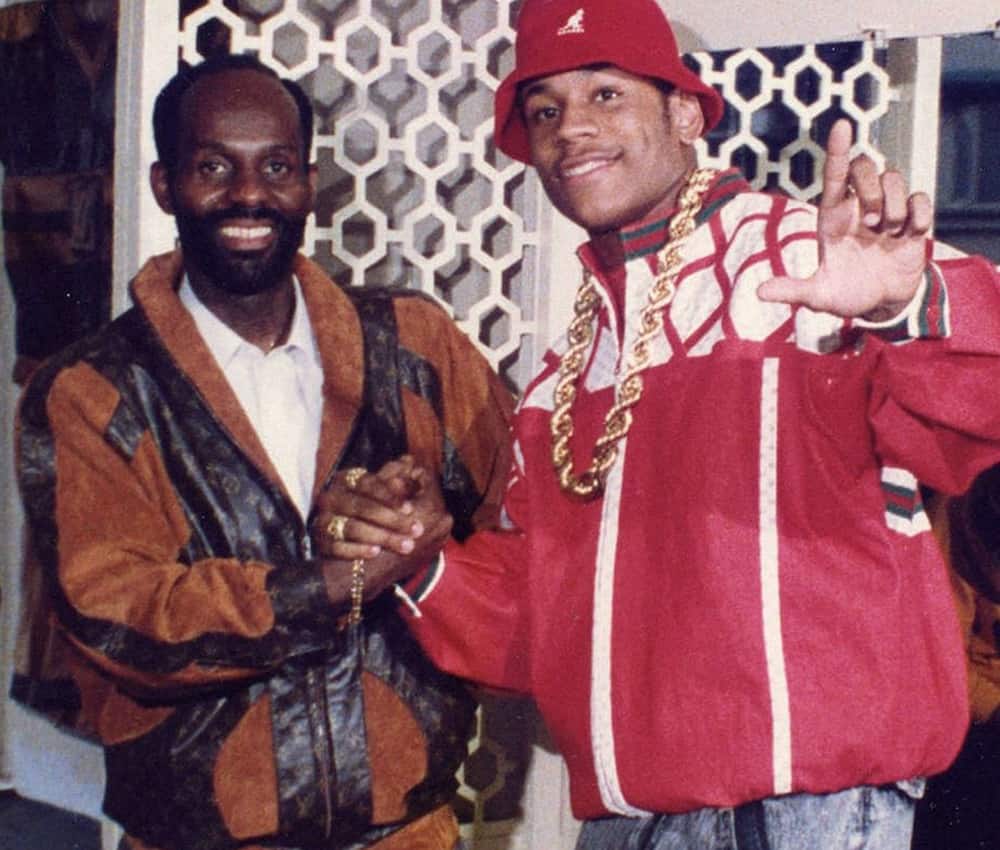 Dapper Dan with LL Cool J, 1986
Dapper Dan with LL Cool J, 1986The Harlem tailor who dressed every 80s rapper that mattered, his creations are immortalised on the covers of Eric B & Rakim’s Paid in Full and Follow the Leader, as well as Salt-n-Pepa’s Icon. “Hip-hop was all about sampling, re-discovering old funk and soul records to flip into something new and fresh,” says stylist Chris Tang. “Dapper Dan applied those same methods to fashion.”
How to wear it now: You can do so literally, if you’ve got a few grand spare, by picking up something from the Gucci capsule collection. If not, think cut-and-paste. “Dapper Dan created these outlandish pieces using the iconic monograms,” says Tang, “then applied them in a way these fashion houses didn’t think to do at the time.” Echo him by going luxuriously logo mad – Fendi on Louis on Gucci on Chanel.
 Dapper Dan x Gucci
Dapper Dan x GucciLo-Life
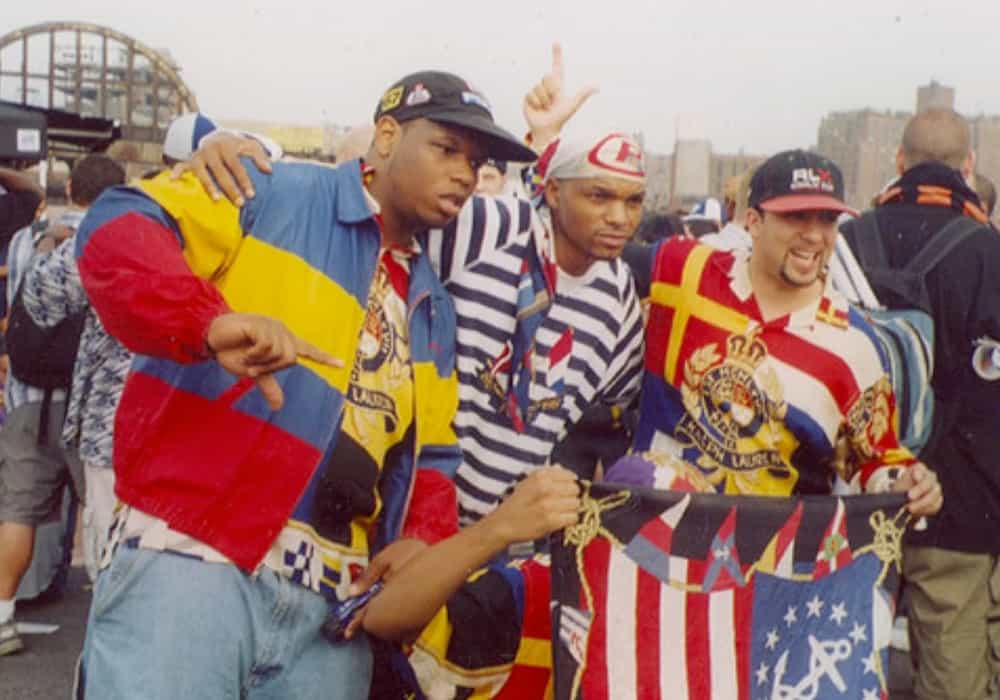 Lo-Life Crew
Lo-Life CrewIn the early 80s, Ralph Lauren marketed its Polo brand as the uniform of WASPS – wealthy, white guys who weekended on their yacht. But its exclusivity had an unintentional effect on hip-hop style. “The Stadium collection enticed the black and latino community all over the US,” says Tang. “The infamous Lo-Life gang became notorious for stealing large amounts of Polo clothing from department stores.”
How to wear it now: “In 1994, Raekwon wore the Snow Beach windbreaker, which earned it its stripes within hip-hop culture,” says Tang. Ralph Lauren wasn’t pleased about it at the time, but has since re-released the collection, as well as a CP-93 America’s Cup capsule, another favourite of the Lo-Heads.

 Ralph Lauren Limited Edition Polo Stadium Collection
Ralph Lauren Limited Edition Polo Stadium CollectionHardcore
 Straight Outta Compton, 2015
Straight Outta Compton, 2015While New York was going big on fur and luxury labels, in LA, NWA stuck to a utilitarian uniform that reflected their sound – black jeans, white tees and hometown baseball caps. They were also big on athletic wear – coach and baseball jackets (often with the Oakland Raiders logo emblazoned on the back), topped off with gold chains as thick as your arm.
How to wear it now: bar the sagged, baggy jeans, everything else in NWA’s look has been reanimated by the 90s revival. Just keep away from costume by losing the Raiders logos, and maybe think dad cap rather than flat peak.
 Hood By Air SS14 Backstage
Hood By Air SS14 BackstagePharrell Brings East To West
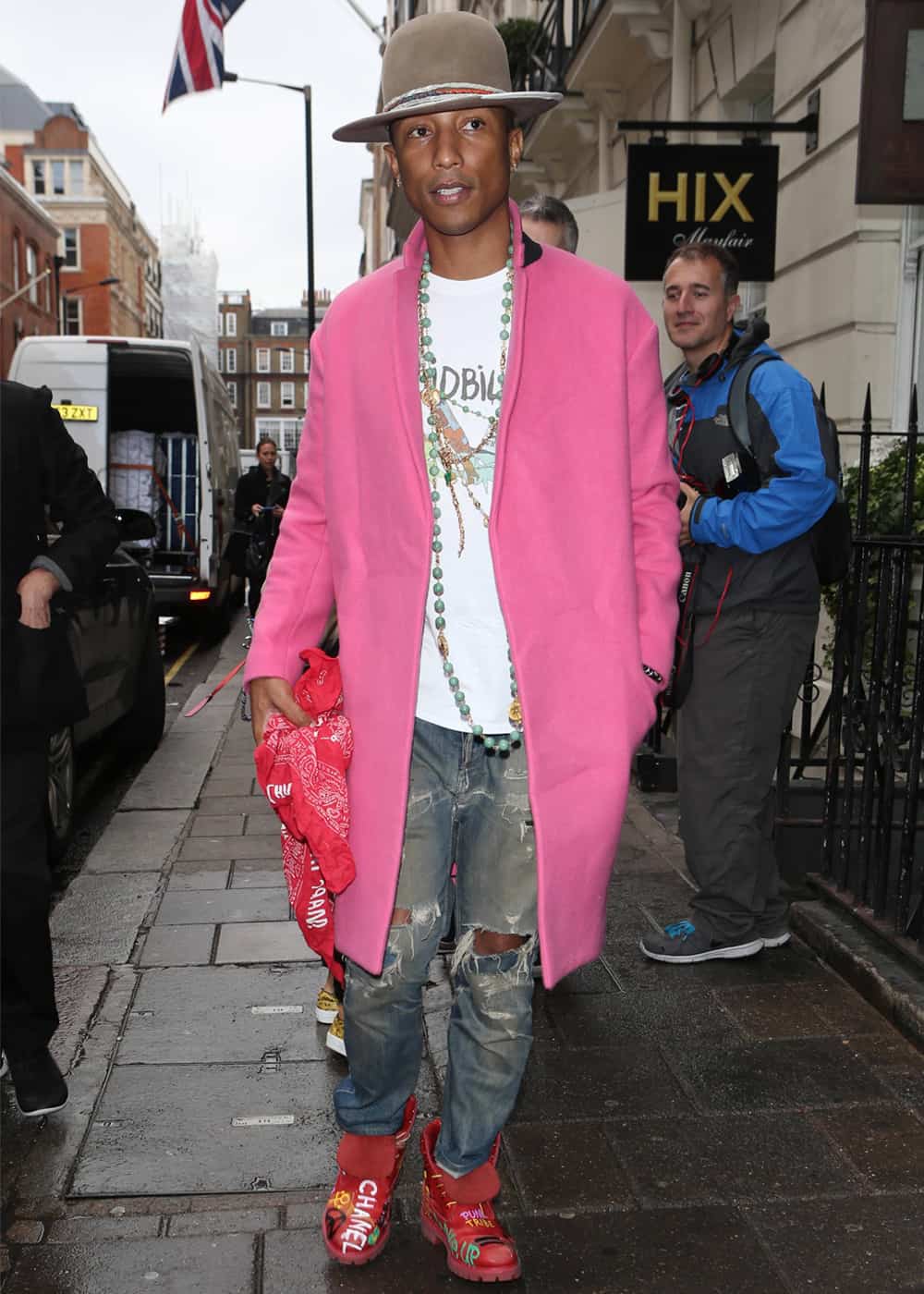 Pharrell Williams
Pharrell WilliamsWhen it seemed every rapper was shilling their own, uninspired fashion label, Pharrell blew apart what hip hop style looked like. In large part that was thanks to his embrace of Japanese brands, particularly A Bathing Ape. “It introduced flamboyant camo print hoodies, rare Bapte-sta trainers and limited silk screen T-shirts,” says Tang. “The idea of a collector’s item and high price point made many people see the brand as something covetable. It was the start of luxury streetwear.”
How to wear it now: Bape’s lost its lustre, after an aggressive expansion stripped it of exclusivity. But Japan remains a hotbed of American-influenced, luxury streetwear brands. As well as OGs like Undercover and Neighbourhood, look to the likes of Wacko Maria, Sasquatchfabrix and Cav Empt, who offer modern spins on hip-hop silhouettes.

 WACKO MARIA Spring/Summer 2018 Collection
WACKO MARIA Spring/Summer 2018 CollectionKanye Reinvents The Sneaker Game
 Kanye West in Yeezy
Kanye West in YeezyKanye West has spent most of his career complaining that he’s not taken seriously as a designer, and while his first attempts at high fashion bombed, with Yeezy he’s become a model for the kind of power and influence rappers can have over fashion and, more importantly, business. Before Kanye, rappers were lucky to be paid to wear a brand’s clothes. Now, they’re at the controls.
How to wear it now: The Yeezy look is all about mixing high and low fashion – a hoodie with a tailored overcoat, trainers with slim-fit jeans. He’s been instrumental in elevating streetwear into something that can be worn anywhere. So, do.
 Yeezy show, New York Fashion Week AW16
Yeezy show, New York Fashion Week AW16
Be the first to comment